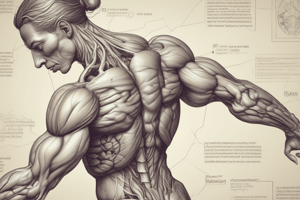Podcast
Questions and Answers
What is an agonist?
What is an agonist?
- A type of nervous tissue
- A muscle that causes or controls joint motion (correct)
- A muscle that stabilizes the body
- A muscle that lengthens when the mover contracts
What is the all-or-none response in muscle fibers?
What is the all-or-none response in muscle fibers?
The property where a muscle fiber contracts fully or not at all.
What is an antagonist muscle?
What is an antagonist muscle?
- A muscle that stabilizes a joint
- A muscle located on the opposite side of a joint (correct)
- A muscle that contracts to produce movement
- A muscle that keeps muscles from moving
What is an aponeurosis?
What is an aponeurosis?
Define concentric action.
Define concentric action.
Contractility refers to a muscle's ability to lengthen with adequate stimulation.
Contractility refers to a muscle's ability to lengthen with adequate stimulation.
What is deep fascia?
What is deep fascia?
What does dynamic force refer to?
What does dynamic force refer to?
What is eccentric action?
What is eccentric action?
Elasticity is the ability of a muscle to shorten and produce force.
Elasticity is the ability of a muscle to shorten and produce force.
What is excitability in muscles?
What is excitability in muscles?
Define extensibility.
Define extensibility.
What is fascia?
What is fascia?
What is a fixator?
What is a fixator?
What does insertion refer to in muscles?
What does insertion refer to in muscles?
Define isometric action.
Define isometric action.
What is isotonic action?
What is isotonic action?
What is maximal stimulus?
What is maximal stimulus?
Define motor unit.
Define motor unit.
What is myoglobin?
What is myoglobin?
What does origin refer to in muscles?
What does origin refer to in muscles?
Define oxygen debt.
Define oxygen debt.
What is resting tone?
What is resting tone?
What does reverse action mean?
What does reverse action mean?
Define sliding filament mechanism.
Define sliding filament mechanism.
What is static force?
What is static force?
Define synergist.
Define synergist.
What is threshold stimulus?
What is threshold stimulus?
What are trigger points?
What are trigger points?
Flashcards are hidden until you start studying
Study Notes
Muscle Terms and Definitions
- Agonist: Muscle responsible for joint motion; also referred to as the mover.
- All-or-none response: Muscle fiber contracts fully or not at all when stimulated.
- Antagonist: Muscle on opposite side of a joint that lengthens when the agonist contracts; performs opposite action.
- Aponeurosis: Broad, flat fibrous connective tissue sheet.
- Concentric Action: Muscle shortens and creates movement when contractile force exceeds opposing force.
- Contractility: Distinct property of muscle tissue that enables it to shorten forcefully upon stimulation.
- Deep Fascia: Dense connective tissue that organizes muscles into functional groups; creates intermuscular compartments.
- Dynamic Force: Force causing movement in an object.
- Eccentric Action: Muscle lengthens while contracting; opposing force exceeds contractile force and controls the mover's action.
- Elasticity: Muscle's ability to return to its resting length after being stretched.
- Excitability: Muscle's capability to receive and respond to stimuli.
- Extensibility: Ability of muscle to stretch and lengthen.
- Fascia: Connective tissue that supports and separates muscles; connects skin to muscle.
- Fixator: Stabilizing muscle that contracts to hold a body part still, allowing another part to move.
- Insertion: Moving attachment point of a muscle; typically distal; where muscle contracts.
- Isometric Action: Muscle contracts without changing length; tension across muscle equals opposing force.
- Isotonic Action: Muscle develops tension while shortening or lengthening.
- Maximal Stimulus: Maximum force of contraction achieved when all motor units are recruited.
- Motor Unit: A motor neuron and all muscle fibers it stimulates.
- Myoglobin: Oxygen-storing red pigment found in muscle cells.
- Origin: Fixed attachment point of a muscle; typically proximal and closest to the midline.
- Oxygen Debt: Extra oxygen required to clear lactic acid from anaerobic glucose metabolism.
- Resting Tone: Constant tension present in muscles at rest.
- Reverse Action: When the origin moves during contraction and the insertion remains fixed.
- Sliding Filament Mechanism: Process by which muscle fibers contract; thick and thin filaments slide over each other.
- Static Force: Force applied without causing movement in an object.
- Synergist: Assisting muscle that contributes to joint movement; can stabilize or support.
- Threshold Stimulus: Minimum stimulus required for observable muscle contraction.
- Trigger Points: Sensitive spots in muscle tissue that cause pain and can lead to referred pain; found in taut bands of muscle.
Studying That Suits You
Use AI to generate personalized quizzes and flashcards to suit your learning preferences.



